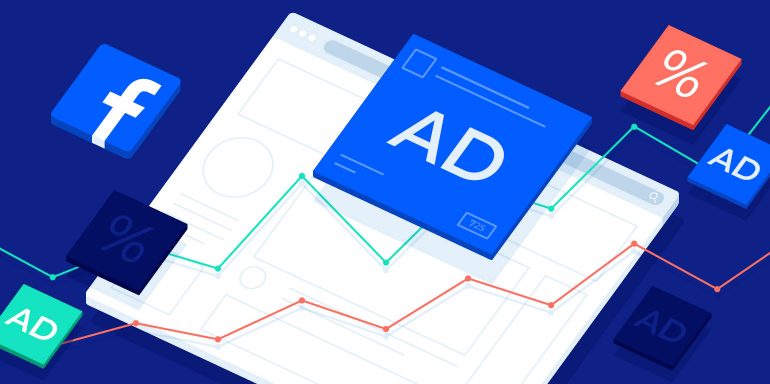We’ve all seen the stats that show just how popular Facebook is. During the fourth quarter of last year, Facebook reported having nearly 1.88 billion daily active users. When you add the company’s in-depth targeting features to this equation, you have a sure-fire recipe for advertising success, right?
Well, not necessarily. You still need to develop a honed and effective campaign strategy. Remember that people on social media get bombarded with ads. In the U.S. alone, the average person is exposed to 4,000 to 10,000 each day. It is critical that you know your target audience and how to reach them so that your ads break through the noise. Optimizing your ads ensures that the advertising dollars you spend deliver not only the highest rate of clicks, but also post-click conversions.
So what does optimizing your ads entail? Let’s dig into what you need to know to maximize your Facebook advertising potential so you maximize your return on ad spend, or ROAS.
1. Choose the right goals and objectives
When you set up a new Facebook ad campaign, the first thing you’ll be asked to do is decide on your objectives. This allows Facebook to align its algorithms to deliver the best results and auto-optimize your campaign accordingly. The menu of objectives contain options that fall under three broad categories: Awareness, Consideration, and Conversions.
⇨ It’s critical to get clear on these objectives from the get go. To do that, decide what your advertising goals are. Ask yourself, what do I want to achieve with this campaign? To help get you on the right track, Facebook has an objectives chart that provides examples of different goals that fall under each objective.
Here is a sampling of common goals and their corresponding objectives:
AWARENESS
GOAL = Increase awareness of your business, brand, or service ⇒ Brand Awareness
GOAL = Maximize your target audience (who sees your ad) ⇒ Reach
CONSIDERATION
GOAL = Send users to a URL such as a landing page or blog post ⇒ Traffic
GOAL = Increase likes, comments, and shares ⇒ Engagement
CONVERSION
GOAL = Encourage people to take a specific action such as sign up for a newsletter, request a demo, download an app, or make a purchase ⇒ Conversions
GOAL = Generate online sales through an e-commerce site ⇒ Catalog Sales
2. Identify and expand your audience
Identifying your target audience and growing your current base are crucial to boosting ROAS. To figure out just who you should be trying to teach, take the guesswork out of the equation and gather meaningful data through Facebook Audience Insights. This robust tool helps you learn important details about the people you should be targeting so you can build personas and develop content that resonates with the right users.
Facebook’s Audience Insights generates aggregated data about the people you’re currently connecting with on Facebook and other Facebook users you should be targeting. Here are examples of the kinds of data that Facebook’s Audience Insights makes visible:
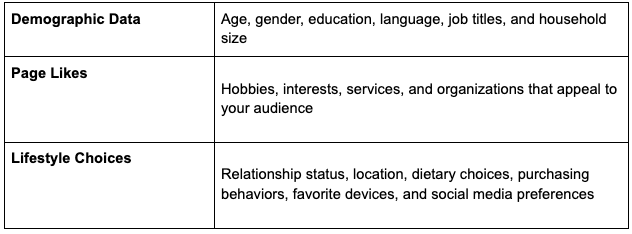
3. Lean into Facebook’s Ads Manager
If there’s one tool that no Facebook ad campaign manager can do without it’s Ads Manager. Think of it as a dashboard that controls all your advertising decision making. Ads Manager assists you in creating ads, managing when and where they’ll run, and tracking their performance. You can set up automated rules that monitor your campaigns, alert you to changes, and even take certain actions for you. But don’t get scared off by these powerful features. First-time advertisers also feel comfortable using Ads Manager.
When you first open Ads Manager, you’ll be able to select your campaign parameters, such as your objective and audience. You can manage your content, upload assets, write ad copy, and see how your ads will look on different devices, as well as make adjustments to your budget, edit ads, and pause or relaunch campaigns.
Ads Manager offers two ways to create an ad: quick creation and guided creation. Quick creation, which tends to be the choice of more advanced advertisers, allows you to design your ad just as you want it in any order that feels right. Guided creation uses a step-by-step wizard to take you through the steps, so it’s a great choice for new advertisers.
Here are some other tasks you can accomplish with Ads Manager:
- Duplicate ads quickly
- Edit your ads all in one place
- View campaign metrics
- Analyze ad performance
- Monitor ads on your computer or mobile device
4. Get creative and increase engagement
There are a host of things you can do to make your ads compelling so they resonate with your target audience. Here are some examples:
Use engaging media: Facebook is a visual medium, so you want your ads to use eye-catching photos and graphics. This ad for the Calm app uses a relaxing video and multiple emojis to get users to download.
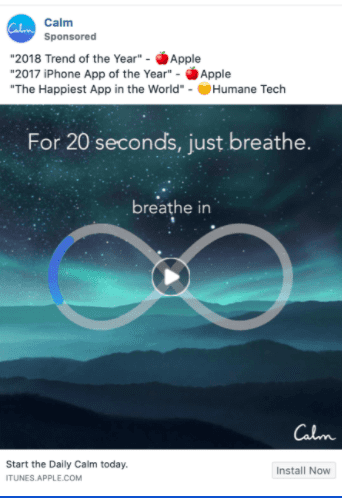
Draft great copy: Get users excited about your offerings by using storytelling, impressive statistics, and testimonials. This Asana ad copy features a testimonial that credibly makes the case that the product can save a lot of employee time.
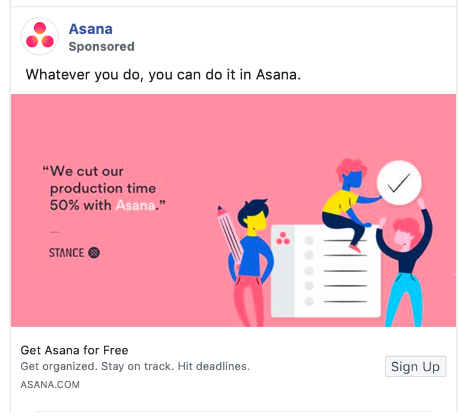
Use the right CTAs: Carefully choose call-to-action buttons from the ones Facebook offers. The CTA should be consistent with your messaging. You don’t want to talk about signing up for an account in the post copy and then include a “Watch Video” CTA. As an example, this Holini ad’s “Learn More” CTA complements the description that describes a helpful article.
In case you feel like you need some extra inspiration, dedicated ad copy generators like HubSpot Campaign Assistant help draft, preview, and edit personalized advertising copy across multiple channels — Facebook Ads included.
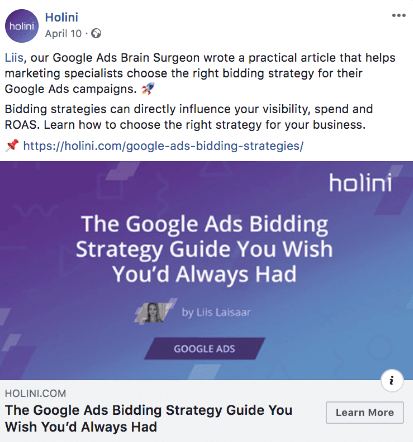
5. Automatically rotate your ads
With social media users experiencing ad fatigue and banner blindness, it can be a challenge to get your ads noticed. A good solution is to create several ad variations within an ad group and set them up so that Facebook rotates them automatically. It actually boosts the effectiveness of your ads because your ads are now competing against each other, and the ads that receive the most clicks are posted.
- ⇨ When conversions start to decrease for the winning ad, and the CPC starts to increase, it’s time to create a new ad group with the same targeting as the winning one and add more variations to the winning ad to keep it fresh.
6. A/B test your Facebook ads
One of the primary components of Facebook ad optimization is finding out what works. The best way to discover new, best-performing ad creatives, copy, and target audiences is by running a quick Facebook A/B test.
Facebook allows you to create A/B tests in multiple ways depending on the variable you want to test. You can create A/B tests from within the Ads Manager Toolbar, which lets you use an existing ad campaign as a template for your test.
To analyze your test results, make sure your hypothesis is clear and measurable and then follow these steps:
- Go to the Ads Manager main table to see all your available ads, campaigns, and ad sets on your ad account.
- Check the box to the left of the campaigns or ad sets you want to use for the A/B test. You can also select “Custom” which duplicates a selected campaign or ad set after which you can edit variables to set up a test.
- Click A/B Test from the toolbar above.
- elect an available variable and follow the on-screen instructions.
7. Leverage click-to-conversion relevancy
Facebook ad clicks are important, but they determine only half of your success story. An effective advertising strategy leveraging ad-to-page relevancy will keep users engaged after they click and wind up in the conversion column.
When we talk about ad-to-page relevancy, we’re referring to the steps needed to ensure that the user’s click-to-conversion journey is relevant and connected. When the message of an ad complements the post-click destination, it fulfills users’ expectations and builds brand trust.
Here are three key ways to achieve click-to-conversion message consistency:
- Be consistent with your messaging. Highlight your offer in your ads and their corresponding post-click destination or landing page. Your message should be consistent, so they know they’re in the right place, though you can vary the copy to keep it interesting.
- Adhere to a similar look and feel. Be consistent with your branding, colors, and calls to action throughout the user’s journey. If it’s disjointed or confusing, you risk experiencing higher bounce rates.
- Use ad targeting data and personalization variables. Ad targeting data, such as visitor intent, connects each ad with a relevant landing page for every unique audience segment. The result is a holistic and effective digital advertising campaign that resonates with your target audience and boosts conversions.
Create highly optimized landing pages to match your ads
Your ROAS is directly related to the relevancy of your ads and their corresponding landing pages. We’re ready to help you level up. Instapage offers three different plans to help take the stress out of building, optimizing, and converting. Schedule an Instapage demo here.
